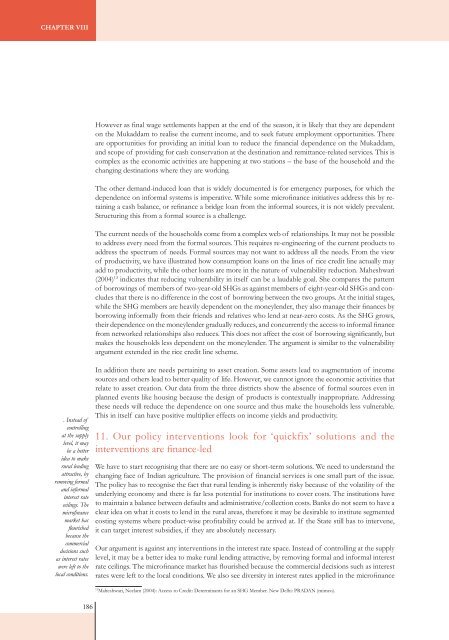SOIL Report 2008 - ACCESS Development Services
SOIL Report 2008 - ACCESS Development Services
SOIL Report 2008 - ACCESS Development Services
You also want an ePaper? Increase the reach of your titles
YUMPU automatically turns print PDFs into web optimized ePapers that Google loves.
Chapter VIIIHowever as final wage settlements happen at the end of the season, it is likely that they are dependenton the Mukaddam to realise the current income, and to seek future employment opportunities. Thereare opportunities for providing an initial loan to reduce the financial dependence on the Mukaddam,and scope of providing for cash conservation at the destination and remittance-related services. This iscomplex as the economic activities are happening at two stations – the base of the household and thechanging destinations where they are working.The other demand-induced loan that is widely documented is for emergency purposes, for which thedependence on informal systems is imperative. While some microfinance initiatives address this by retaininga cash balance, or refinance a bridge loan from the informal sources, it is not widely prevalent.Structuring this from a formal source is a challenge.The current needs of the households come from a complex web of relationships. It may not be possibleto address every need from the formal sources. This requires re-engineering of the current products toaddress the spectrum of needs. Formal sources may not want to address all the needs. From the viewof productivity, we have illustrated how consumption loans on the lines of rice credit line actually mayadd to productivity, while the other loans are more in the nature of vulnerability reduction. Maheshwari(2004) 13 indicates that reducing vulnerability in itself can be a laudable goal. She compares the patternof borrowings of members of two-year-old SHGs as against members of eight-year-old SHGs and concludesthat there is no difference in the cost of borrowing between the two groups. At the initial stages,while the SHG members are heavily dependent on the moneylender, they also manage their finances byborrowing informally from their friends and relatives who lend at near-zero costs. As the SHG grows,their dependence on the moneylender gradually reduces, and concurrently the access to informal financefrom networked relationships also reduces. This does not affect the cost of borrowing significantly, butmakes the households less dependent on the moneylender. The argument is similar to the vulnerabilityargument extended in the rice credit line scheme.. Instead ofcontrollingat the supplylevel, it maybe a betteridea to makerural lendingattractive, byremoving formaland informalinterest rateceilings. Themicrofinancemarket hasflourishedbecause thecommercialdecisions suchas interest rateswere left to thelocal conditions.In addition there are needs pertaining to asset creation. Some assets lead to augmentation of incomesources and others lead to better quality of life. However, we cannot ignore the economic activities thatrelate to asset creation. Our data from the three districts show the absence of formal sources even inplanned events like housing because the design of products is contextually inappropriate. Addressingthese needs will reduce the dependence on one source and thus make the households less vulnerable.This in itself can have positive multiplier effects on income yields and productivity.11. Our policy interventions look for ‘quickfix’ solutions and theinterventions are finance-ledWe have to start recognising that there are no easy or short-term solutions. We need to understand thechanging face of Indian agriculture. The provision of financial services is one small part of the issue.The policy has to recognise the fact that rural lending is inherently risky because of the volatility of theunderlying economy and there is far less potential for institutions to cover costs. The institutions haveto maintain a balance between defaults and administrative/collection costs. Banks do not seem to have aclear idea on what it costs to lend in the rural areas, therefore it may be desirable to institute segmentedcosting systems where product-wise profitability could be arrived at. If the State still has to intervene,it can target interest subsidies, if they are absolutely necessary.Our argument is against any interventions in the interest rate space. Instead of controlling at the supplylevel, it may be a better idea to make rural lending attractive, by removing formal and informal interestrate ceilings. The microfinance market has flourished because the commercial decisions such as interestrates were left to the local conditions. We also see diversity in interest rates applied in the microfinance13Maheshwari, Neelam (2004): Access to Credit: Determinants for an SHG Member. New Delhi: PRADAN (mimeo).186














